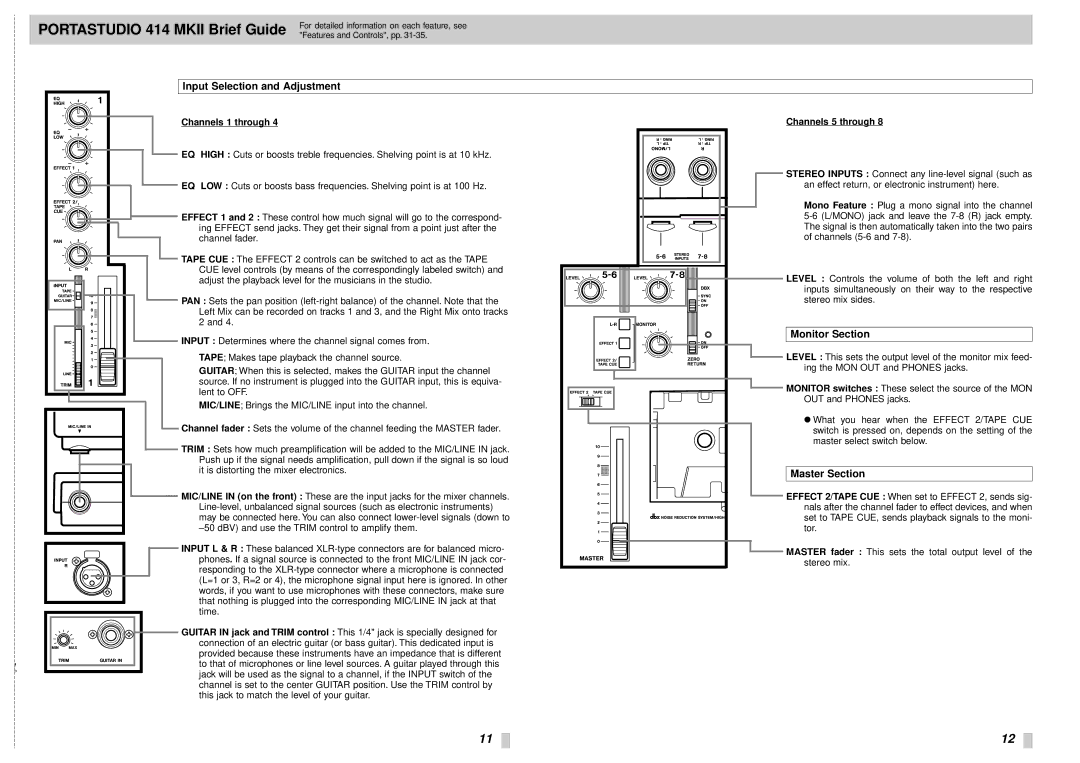
PORTASTUDIO 414 MKII Brief Guide | For detailed information on each feature, see |
"Features and Controls", pp. | |
|
|
Input Selection and Adjustment
✂
Channels 1 through 4
EQ HIGH : Cuts or boosts treble frequencies. Shelving point is at 10 kHz.
EQ LOW : Cuts or boosts bass frequencies. Shelving point is at 100 Hz.
![]()
![]()
![]() EFFECT 1 and 2 : These control how much signal will go to the correspond-
EFFECT 1 and 2 : These control how much signal will go to the correspond-
ing EFFECT send jacks. They get their signal from a point just after the channel fader.
TAPE CUE : The EFFECT 2 controls can be switched to act as the TAPE CUE level controls (by means of the correspondingly labeled switch) and adjust the playback level for the musicians in the studio.
PAN : Sets the pan position
INPUT : Determines where the channel signal comes from.
TAPE; Makes tape playback the channel source.
GUITAR; When this is selected, makes the GUITAR input the channel source. If no instrument is plugged into the GUITAR input, this is equiva- lent to OFF.
MIC/LINE; Brings the MIC/LINE input into the channel.
Channel fader : Sets the volume of the channel feeding the MASTER fader.
TRIM : Sets how much preamplification will be added to the MIC/LINE IN jack. Push up if the signal needs amplification, pull down if the signal is so loud it is distorting the mixer electronics.
MIC/LINE IN (on the front) : These are the input jacks for the mixer channels.
INPUT L & R : These balanced
![]() GUITAR IN jack and TRIM control : This 1/4" jack is specially designed for connection of an electric guitar (or bass guitar). This dedicated input is provided because these instruments have an impedance that is different to that of microphones or line level sources. A guitar played through this jack will be used as the signal to a channel, if the INPUT switch of the channel is set to the center GUITAR position. Use the TRIM control by this jack to match the level of your guitar.
GUITAR IN jack and TRIM control : This 1/4" jack is specially designed for connection of an electric guitar (or bass guitar). This dedicated input is provided because these instruments have an impedance that is different to that of microphones or line level sources. A guitar played through this jack will be used as the signal to a channel, if the INPUT switch of the channel is set to the center GUITAR position. Use the TRIM control by this jack to match the level of your guitar.
Channels 5 through 8
STEREO INPUTS : Connect any
Mono Feature : Plug a mono signal into the channel
![]()
![]()
![]() LEVEL : Controls the volume of both the left and right
LEVEL : Controls the volume of both the left and right
inputs simultaneously on their way to the respective stereo mix sides.
Monitor Section
![]() LEVEL : This sets the output level of the monitor mix feed- ing the MON OUT and PHONES jacks.
LEVEL : This sets the output level of the monitor mix feed- ing the MON OUT and PHONES jacks.
![]() MONITOR switches : These select the source of the MON
MONITOR switches : These select the source of the MON
OUT and PHONES jacks.
– What you hear when the EFFECT 2/TAPE CUE switch is pressed on, depends on the setting of the master select switch below.
Master Section
EFFECT 2/TAPE CUE : When set to EFFECT 2, sends sig- nals after the channel fader to effect devices, and when set to TAPE CUE, sends playback signals to the moni- tor.
![]() MASTER fader : This sets the total output level of the stereo mix.
MASTER fader : This sets the total output level of the stereo mix.
11 |
| 12 |
